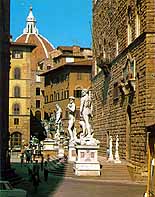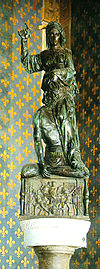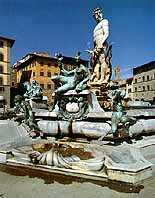
The statues in front of the
facade of Palazzo Vecchio
The square is adorned with a large number of statues. Apart from those under the Loggia dei Lanzi, at one time many sculptures stood lined up in front of the facade of Palazzo Vecchio and on the Aringhiera, which was a sort of platform for public speaking situated right in front of the entrance. Set up in 1323 and destroyed in the 19th century, we can get an exact idea of what the Aringhiera looked like in a fresco in the Room of Leo X in Palazzo Vecchio.

Donatello,
Judith and Holophernes
Three works of genius once stood in front of the facade, alongside the rather mediocre statues of Hercules and Cacus in marble by Baccio Bandinelli (1534), which is still there, and which have, for various reasons, since become part of history: Michelangelo's David (1501-4), the Marzocco (1418) and Donatello's Judith and Holofernes (1455-60). All three have since been replaced by copies and the originals can be found respectively in the Academy Gallery (since 1873), the Bargello Museum (since 1885) and the Room of Lilies in Palazzo Vecchio. However it only seems right to have kept a record of these works, even if they are copies, because they are all symbols of the Florentine Republic: the Marzocco because it is one of the oldest emblems of the city, the Judith and the David because their subjects contain implicit allusions of civil liberties and virtues.

Ammannati, Fountain of Neptune
The two latter sculptures, moreover, testify to particular moments in history. The Judith is linked with the expulsion of the Medici (1494), which took place after the death of Lorenzo the Magnificent (the statue was brought here from Palazzo Medici Riccardi in Via Larga after it was sacked), while the David exalts the fight of the Second Florentine Republic (1494-1512) against two "Goliaths": Charles VIII, king of France, and Pope Alexander VI Borgia.
The enormous mass of the Fountain of Neptune (1565-75), a marble sculpture by Bartolomeo Ammannati, with Tritons and Water Nymphs in bronze by Giambologna, is situated on the corner of Palazzo Vecchio. Created for the celebration of the wedding between Francesco de' Medici (Cosimo I's heir) and Joan of Austria, the Fountain of Neptune is full of allegorical meaning, though somewhat lacking in power of expression; the bronzes by Giambologna are the best part of it. The sarcastic Florentines, who immediately nicknamed the Neptune "Biancone", invented a catch phrase that went rather like this: Ammannato, Ammannato, what a lot of marble you have spoiled".

Giambologna,
equestrian statua of Cosimo I
Nearby, the equestrian statue of Cosimo I dÈ Medici, cast in bronze by Giambologna on a commission from Francesco I, dominates the northern part of the square. The work was ordered in 1587 and a foundry had to be especially created to cast it. The horse was ready in in 1591, cast in a single piece by the experienced armourers of the Duke, while the figure of Cosimo and the pedestal with three bas-reliefs illustrating the most important periods in his life, were completed in 1594: when he was elected duke (1537), his conquest of Siena (1555) and when he was granted the title of Grand Duke (1569).
The statue immediately became so famous that apparently the same mould was also used to cast the horse for the similar monument to Henry IV of Bourbon, commissioned by his widow, Queen Maria de' Medici .
